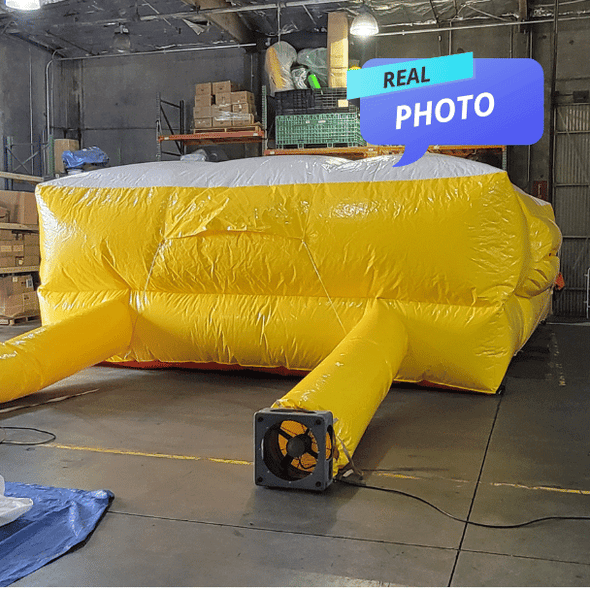Rescue & fire Department

Discover the pinnacle of safety in high-risk environments with i2k's Rescue Airpads. Crafted for efficiency in emergency scenarios, these robust inflatables redefine standards for rescue operations, offering a reliable and versatile solution for safely rescuing individuals from elevated positions. Whether in construction sites, industrial settings, or emergency response situations, our inflatable structures prioritize functionality, safety, and adaptability, ensuring a secure and efficient platform for dynamic rescue missions.
- Product
- Qty in Cart
- Quantity
- Price
- Subtotal
-


AirPac Model 70
i2k AirPad
Description: Maximum Height: Rated at 70 ft. (21m) Comparable to a fall from the 7th floor of an average building. Used by fire departments and rescue teams for training and emergencies. Air Packs are designed to accept ONE person at a time and...Qty in Cart: 0Price:Subtotal: -


AirPac Model 100
i2k AirPad
Description: Maximum Height: Rated at 100' (30 m) Comparable to a fall from the 10th floor of an average office building Safety AirPacs are manufactured using fire retardant, 15/18oz vinyl reinforced fabric, per mil spec C 20696 &CC 10-191-5902-5910...Qty in Cart: 0Price:Subtotal:
Elevating Safety: Technology of Rescue Air Bags
In the realm of emergency response and disaster management, innovation is key to saving lives. One helpful tool for rescue operations is the rescue air bag, among many others available for this purpose. These inflatable marvels serve as a lifeline in precarious situations, offering rapid deployment and reliable support when every second counts. Let's delve into the world of rescue air bags, exploring their functions, benefits, and the vital role they play in modern rescue efforts.
Cost Concerns: The Barrier to Entry
One of the primary concerns potential customers face when considering rescue air bags is the initial investment cost. These devices can be expensive, especially for individuals or organizations with limited budgets. The cost of rescue air bags may deter some customers from making the purchase, despite recognizing the critical role they play in emergency response.
Addressing this concern requires a careful examination of the long-term benefits and cost savings associated with rescue air bags. While the initial investment may seem significant, the potential lives saved and the reduction in property damage during rescue operations can far outweigh the upfront expense. Additionally, exploring financing options or seeking grants and funding opportunities can help alleviate the financial burden for organizations committed to enhancing their emergency response capabilities.
Training Requirements: Ensuring Competency
Another significant consideration for customers is the training required to effectively use rescue air bags. Proper training is essential to ensure safe and efficient operation, but it also adds to the overall cost and time commitment. Customers may be hesitant to invest in rescue air bags if they anticipate challenges in providing comprehensive training to their personnel.
To address this concern, manufacturers and suppliers of rescue air bags should offer comprehensive training programs tailored to the needs of different users, including emergency responders, industrial workers, and disaster relief organizations. These training programs should cover topics such as proper deployment techniques, safety protocols, equipment maintenance, and emergency procedures. Additionally, incorporating hands-on training sessions and simulations can enhance learning outcomes and ensure competency among users.
Maintenance and Repairs: Keeping Operations Running Smoothly
Like any equipment, rescue air bags require regular maintenance and occasional repairs to ensure optimal performance. Customers may be concerned about the ongoing costs associated with maintaining their air bags, including servicing, replacement parts, and potential downtime during repairs. These considerations can add to the total cost of ownership over time.
To mitigate concerns about maintenance and repairs, manufacturers should provide clear guidelines and recommendations for routine maintenance tasks, such as inspections, cleaning, and lubrication. Additionally, offering warranty packages and service contracts can provide customers with peace of mind and financial protection against unexpected repair costs. By promoting proactive maintenance practices and providing responsive customer support, manufacturers can help customers maximize the lifespan and performance of their rescue air bags.
Compatibility and Integration: Seamlessly Incorporating into Existing Systems
Customers may also face challenges regarding the compatibility of rescue air bags with existing equipment and procedures. Integration with other rescue tools and systems, such as hydraulic rescue tools or vehicle stabilization equipment, is crucial for seamless operation. Customers may hesitate to invest in air bags if they anticipate difficulties in integrating them into their current workflows or if they require additional adaptations or accessories for compatibility.
To address compatibility concerns, manufacturers should design rescue air bags with versatile features and flexible configurations that allow for easy integration with a wide range of rescue equipment and procedures. Providing compatibility guides, instructional materials, and technical support can help customers navigate the integration process and ensure smooth operation in emergency situations. Additionally, collaborating with other manufacturers and industry stakeholders to develop standardized interfaces and interoperable systems can simplify the integration of rescue air bags into existing rescue operations.
Storage and Transport: Practical Considerations
The storage and transport of rescue air bags present practical challenges for customers, particularly for organizations with limited space or specialized transportation needs. These devices can be bulky and require specific storage conditions to maintain their integrity and functionality. Customers may need to consider factors such as storage space availability, transportation logistics, and the ability to deploy air bags quickly in emergency situations.
To address storage and transport concerns, manufacturers should prioritize compact and lightweight designs that optimize space utilization and facilitate easy handling and transportation. Offering modular storage solutions, such as stackable containers or portable carrying cases, can help customers organize and transport rescue air bags efficiently. Additionally, providing guidance on proper storage practices, such as storing air bags in a clean, dry environment away from direct sunlight and extreme temperatures, can help prolong their lifespan and maintain their performance over time.
In conclusion, while rescue air bags are invaluable assets for emergency responders, potential customers may encounter several pain points that influence their purchasing decisions. By addressing concerns related to cost, training, maintenance, compatibility, and practical considerations, manufacturers and suppliers can help alleviate customer hesitations and promote the widespread adoption of rescue air bags for enhanced safety and effectiveness in rescue operations. These air lifting bag systems play a pivotal role in enabling rapid and efficient rescue operations, embodying the spirit of innovation and dedication to saving lives.
